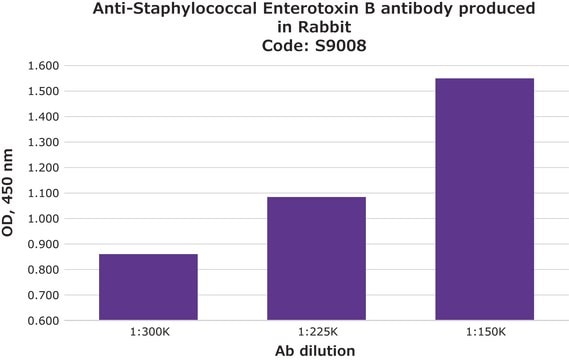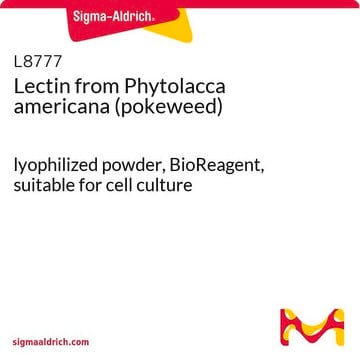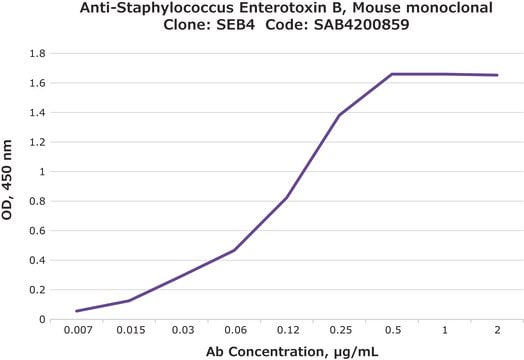T-cells stimulated with SEB produce high levels of IFN-γ, while PHA-stimulated T-cells produce little or no IFN-γ. For more information, refer to the reference at the following link: https://pmc.ncbi.nlm.nih.gov/articles/PMC1906565/#:~:text=%2Dcells%20(Fig.-,1).,compared%20to%20CD4+%20T%2Dcells
S4881
Staphylococcal enterotoxin B from Staphylococcus aureus
Sinónimos:
Enterotoxin B, Staphylococcal, SEB
About This Item
Productos recomendados
contiene
sodium phosphate buffer as balance
Nivel de calidad
composición
Protein, ~25% Lowry
disponibilidad
not available in USA
impurezas
Staphylococcal enterotoxin A (SEA), essentially free
aplicaciones
metabolomics
vitamins, nutraceuticals, and natural products
temp. de almacenamiento
2-8°C
¿Está buscando productos similares? Visita Guía de comparación de productos
Categorías relacionadas
Aplicación
Acciones bioquímicas o fisiológicas
Envase
Producto relacionado
Palabra de señalización
Danger
Frases de peligro
Consejos de prudencia
Clasificaciones de peligro
Acute Tox. 1 Dermal - Acute Tox. 1 Inhalation - Acute Tox. 1 Oral - Eye Irrit. 2 - Skin Irrit. 2 - STOT SE 3
Órganos de actuación
Respiratory system
Código de clase de almacenamiento
6.1A - Combustible acute toxic Cat. 1 and 2 / very toxic hazardous materials
Clase de riesgo para el agua (WGK)
WGK 3
Punto de inflamabilidad (°F)
Not applicable
Punto de inflamabilidad (°C)
Not applicable
Elija entre una de las versiones más recientes:
Certificados de análisis (COA)
¿No ve la versión correcta?
Si necesita una versión concreta, puede buscar un certificado específico por el número de lote.
¿Ya tiene este producto?
Encuentre la documentación para los productos que ha comprado recientemente en la Biblioteca de documentos.
-
What is the difference in effects on T-lymphocyte proliferation between PHA and SEB? Thank you
1 answer-
Helpful?
-
-
How can I determine the shelf life / expiration / retest date of this product?
1 answer-
If this product has an expiration or retest date, it will be shown on the Certificate of Analysis (COA, CofA). If there is no retest or expiration date listed on the product's COA, we do not have suitable stability data to determine a shelf life. For these products, the only date on the COA will be the release date; a retest, expiration, or use-by-date will not be displayed.
For all products, we recommend handling per defined conditions as printed in our product literature and website product descriptions. We recommend that products should be routinely inspected by customers to ensure they perform as expected.
For products without retest or expiration dates, our standard warranty of 1 year from the date of shipment is applicable.
For more information, please refer to the Product Dating Information document: https://www.sigmaaldrich.com/deepweb/assets/sigmaaldrich/marketing/global/documents/449/386/product-dating-information-mk.pdfHelpful?
-
-
How is shipping temperature determined? And how is it related to the product storage temperature?
1 answer-
Products may be shipped at a different temperature than the recommended long-term storage temperature. If the product quality is sensitive to short-term exposure to conditions other than the recommended long-term storage, it will be shipped on wet or dry-ice. If the product quality is NOT affected by short-term exposure to conditions other than the recommended long-term storage, it will be shipped at ambient temperature. As shipping routes are configured for minimum transit times, shipping at ambient temperature helps control shipping costs for our customers. For more information, please refer to the Storage and Transport Conditions document: https://www.sigmaaldrich.com/deepweb/assets/sigmaaldrich/marketing/global/documents/316/622/storage-transport-conditions-mk.pdf
Helpful?
-
-
こんにちは、この商品の容量をお聞きしたいのですが、1MGと表記されている場合、1miligramということでしょうか? 溶かしてから調剤したいのですが。 溶かして調剤する際のプロトコルはあるのでしょうか?
1 answer-
Yes, the 1MG does stand for one milligram. The product is soluble in water at 4 mg/ml. It may also be dissolved in an aqueous buffer such as PBS. See the link below to the product information sheet for additional solution stability information:
https://www.sigmaaldrich.com/deepweb/assets/sigmaaldrich/product/documents/126/857/s4881pis.pdfHelpful?
-
Active Filters
Nuestro equipo de científicos tiene experiencia en todas las áreas de investigación: Ciencias de la vida, Ciencia de los materiales, Síntesis química, Cromatografía, Analítica y muchas otras.
Póngase en contacto con el Servicio técnico









